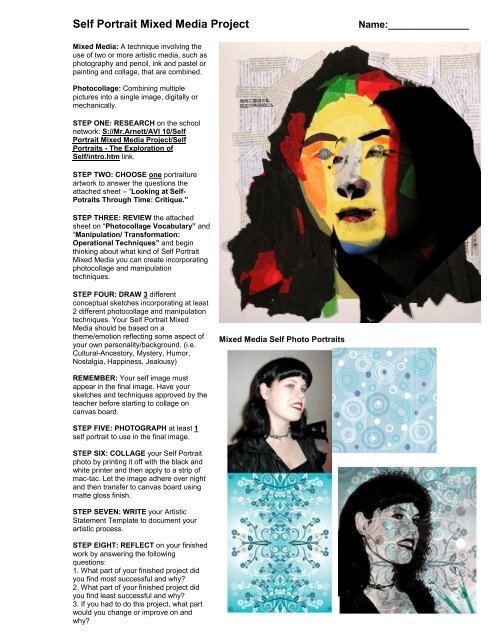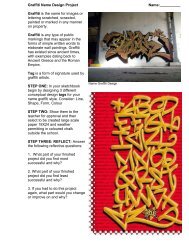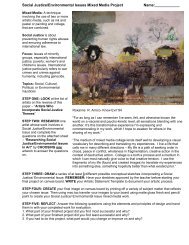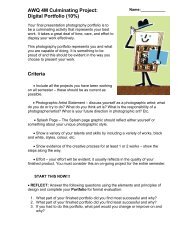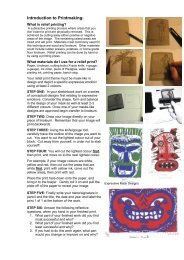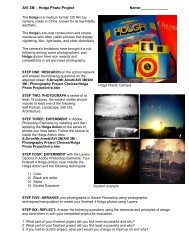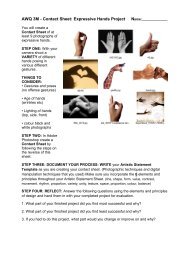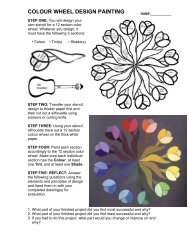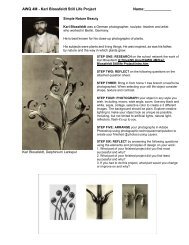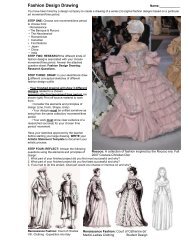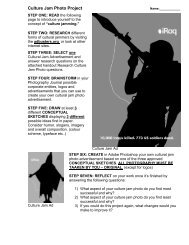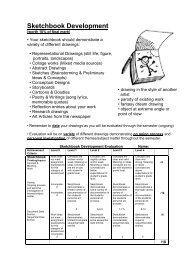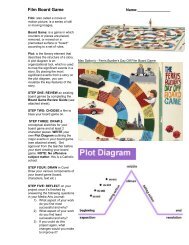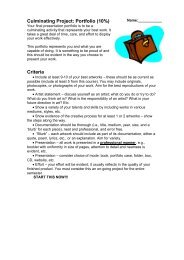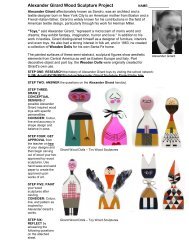Self Portrait Mixed Media Project (.PDF)
Self Portrait Mixed Media Project (.PDF)
Self Portrait Mixed Media Project (.PDF)
Create successful ePaper yourself
Turn your PDF publications into a flip-book with our unique Google optimized e-Paper software.
<strong>Self</strong> <strong>Portrait</strong> <strong>Mixed</strong> <strong>Media</strong> <strong>Project</strong> Name:_______________<br />
<strong>Mixed</strong> <strong>Media</strong>: A technique involving the<br />
use of two or more artistic media, such as<br />
photography and pencil, ink and pastel or<br />
painting and collage, that are combined.<br />
Photocollage: Combining multiple<br />
pictures into a single image, digitally or<br />
mechanically.<br />
STEP ONE: RESEARCH on the school<br />
network: S://Mr.Arnett/AVI 10/<strong>Self</strong><br />
<strong>Portrait</strong> <strong>Mixed</strong> <strong>Media</strong> <strong>Project</strong>/<strong>Self</strong><br />
<strong>Portrait</strong>s - The Exploration of<br />
<strong>Self</strong>/intro.htm link.<br />
STEP TWO: CHOOSE one portraiture<br />
artwork to answer the questions the<br />
attached sheet – “Looking at <strong>Self</strong>-<br />
Potraits Through Time: Critique.”<br />
STEP THREE: REVIEW the attached<br />
sheet on “Photocollage Vocabulary” and<br />
“Manipulation/ Transformation:<br />
Operational Techniques” and begin<br />
thinking about what kind of <strong>Self</strong> <strong>Portrait</strong><br />
<strong>Mixed</strong> <strong>Media</strong> you can create incorporating<br />
photocollage and manipulation<br />
techniques.<br />
STEP FOUR: DRAW 3 different<br />
conceptual sketches incorporating at least<br />
2 different photocollage and manipulation<br />
techniques. Your <strong>Self</strong> <strong>Portrait</strong> <strong>Mixed</strong><br />
<strong>Media</strong> should be based on a<br />
theme/emotion reflecting some aspect of<br />
your own personality/background. (i.e.<br />
Cultural-Ancestory, Mystery, Humor,<br />
Nostalgia, Happiness, Jealousy)<br />
REMEMBER: Your self image must<br />
appear in the final image. Have your<br />
sketches and techniques approved by the<br />
teacher before starting to collage on<br />
canvas board.<br />
STEP FIVE: PHOTOGRAPH at least 1<br />
self portrait to use in the final image.<br />
STEP SIX: COLLAGE your <strong>Self</strong> <strong>Portrait</strong><br />
photo by printing it off with the black and<br />
white printer and then apply to a strip of<br />
mac-tac. Let the image adhere over night<br />
and then transfer to canvas board using<br />
matte gloss finish.<br />
STEP SEVEN: WRITE your Artistic<br />
Statement Template to document your<br />
artistic process.<br />
STEP EIGHT: REFLECT on your finished<br />
work by answering the following<br />
questions:<br />
1. What part of your finished project did<br />
you find most successful and why?<br />
2. What part of your finished project did<br />
you find least successful and why?<br />
3. If you had to do this project, what part<br />
would you change or improve on and<br />
why?<br />
<strong>Mixed</strong> <strong>Media</strong> <strong>Self</strong> Photo <strong>Portrait</strong>s
K/U: Looking at <strong>Self</strong>-<strong>Portrait</strong>s Through Time: Critique Name:____________<br />
Name of Chosen Artwork:____________________<br />
Artist Name:________________________________<br />
DESCRIPTION<br />
1. Describe what kind of work it is (i.e drawing,<br />
painting etc.): (1)<br />
2. Provide a brief biography of the artist and<br />
information about the artistic style: (2)<br />
Thumbnail sketch of chosen self<br />
portrait work<br />
ANALYSIS<br />
1. Choose 6 elements and principles of design and analyze how they are used in the work:<br />
(line, shape, colour, form, movement, rhythm, contrast, texture, balance, variety,<br />
proportion, unity, emphasis, space) (6)<br />
1. -<br />
2. -<br />
3. -<br />
4. -<br />
5. -<br />
6. -<br />
2. How has the artist used his/her materials to create their image?<br />
(Traditional/Technological/Hybrid materials) and to what effect? (2)
INTERPRETATION<br />
1. Based on what you have learned about this artwork, what do you think the artist was trying to say?<br />
(1)<br />
2. What feeling does the artwork evoke in you? (1)<br />
3. Do you think there are symbols in this artwork which reinforce its meaning? Describe how these<br />
work. (1)<br />
4. Do you think the artist effectively organized the elements and principles of design and explain why<br />
or why not? (2)<br />
JUDGEMENT<br />
1. Do you like this artwork? Why or why not? (Base your answers on what you have learned) Explain.<br />
(2)
Artistic Statement Template Name:____________<br />
Artwork Title:______________________________________________<br />
A) Research Questions<br />
In what new ways can images and photo materials be re-combined or integrated to challenge<br />
accepted views of representation?<br />
B) Photocollage, Manipulation/Transformation, Operational techniques used in my work<br />
and how they support my intended visual message:<br />
C) REFLECT by answering the following questions using the elements & principles of design:<br />
1. What part of your finished project did you find most successful and why?<br />
2. What part of your finished project did you find least successful and why?<br />
3. If you had to do this project, what part would you change or improve on and why?
Photocollage Vocabulary<br />
Photocollage: Combining multiple pictures into a single<br />
image, digitally or mechanically.<br />
Base Picture: The image(s) chosen to be the foundation of<br />
your photomontage.<br />
Pictorial Element: An object or person taken from another<br />
picture.<br />
Proportion: The relationship between picture elements (size<br />
and placement).<br />
Mechanical Photocollage<br />
Layering of picture elements by hand using a 35-mm camera<br />
and manual cutting and pasting tools.<br />
The final image can be photographed for a ‘seamless’ effect.<br />
Digital Photocollage: Layering of picture elements through<br />
the use of digital imaging computer software, such as<br />
Photoshop, etc.<br />
Scanner: Image input device which converts analog pictures<br />
into digital form.<br />
Digital Camera: Camera which saves images in digital form,<br />
thereby making it easy to input images into a digital imaging<br />
software program.<br />
Special Effects: Enhancing images digitally or mechanically<br />
through the use of hand-colouring, airbrushing, and other<br />
photographic controls (e.g., depth of field, blurring)<br />
Building a Photocollage: Basic Concepts<br />
These concepts can be applied to both digital and mechanical methods of<br />
creating a photocollage.<br />
1. SETTING THE STAGE<br />
• Start with a base picture; add a backdrop; establish foreground,<br />
middleground, background<br />
2. ADD PICTURE ELEMENTS<br />
• Adjust placement/arrangement of picture elements according to<br />
whether they belong in the foreground, middleground, or<br />
background<br />
3. ESTABLISH PROPORTION<br />
• Adjust size and placement of picture elements to produce a<br />
cohesive final product.<br />
4. DIRECT THE ACTION (Placement of picture elements will affect the<br />
dynamic of the image.)<br />
5. INCORPORATE LIGHT AND SHADOW<br />
Light works to enhance desired atmosphere; direct viewer’s eyes;<br />
and integrate picture elements.<br />
Shadows:<br />
• harsh/dark shadows indicate a bright light source; light-coloured<br />
shadows indicate softer light<br />
• hard-edged shadows indicate that the object casting the shadow<br />
is close to whatever the shadow is falling on; soft-edged<br />
shadows indicate that the shadow has travelled a great distance<br />
6. INCORPORATE SPECIAL EFFECTS (hand-colouring, airbrushing,<br />
filters)<br />
7. OUTPUT/TRANSFER<br />
• Onto a variety of supports if completed mechanically (paper,<br />
wood, walls, furniture, doors, etc.)<br />
• Onto a variety of papers if completed digitally (watercolour paper,<br />
photographic paper, transfer paper, transparency for project<br />
purposes, T-shirts)<br />
• Onto screen, wall, etc. through use of LCD projector if completed<br />
digitally
Manipulation/Transformation: Operational Techniques<br />
1. Magnification: The “reconstruction” of a subject on a much larger scale than that of the original; for<br />
example, a pencil sharpener, eight feet high as a subject for sculpture.<br />
2. Minification: Making an object appear smaller; for example, an “art museum” created the size of a<br />
shoe box.<br />
3. Multiplication: Repeating images or forms within a composition, a grid structure, a kaleidoscopic<br />
pattern in reflected images.<br />
4. Substitution: Changing the original qualities of objects and surfaces: a “soft” telephone, a “wooden”<br />
light bulb, a “concrete” pillow.<br />
5. Reversals: Reversing colour, perspective, functions, relatives sizes and so on; reversing the “laws of<br />
nature”, such as gravity.<br />
6. Fragmentation: Splitting or fragmenting objects or images. The subject may be either partially<br />
developed, fragmented, or dismembered. Splitting planes, as in Cubist art.<br />
7. Partial Delineation: Drawing, carving, or presenting only a portion of an image in its finished state;<br />
depicting an image emerging or becoming engulfed in its environment Michaelangelo’s unfinished<br />
Slaves, for example.<br />
8. Distortion: Changing an object or image by deformation, distortion, or progressive states of<br />
degradation: burned, dissolved, decomposed, crushed, cracked.<br />
9. Disguising: The use of latent or hidden images; obscuring the qualities of an object by wrapping,<br />
masking or camouflaging.<br />
10. Metamorphosis: Depicting images or forms in progressive states of change.<br />
11. Transmutations: A radical form of metamorphosis; creating Jekyll and Hyde transformations,<br />
mutations, alterations, hybridizations, re-materializations.<br />
12. Simultaneity: Presenting several views or time modes simultaneously, for example simultaneous<br />
presentations of side, top, back, and bottom views, as in Cubist painting; temporal dislocations, such as<br />
the simultaneous presentation of childhood and adult memories or various time space situations;<br />
simultaneous presentation of different sensory experiences.<br />
13. Soft Focus: Changing focus of all an image; blurred edges or contour lines; photographic images<br />
blurred by movement or panning.<br />
14. Transference: The intrusion of an object or elements into a space or environment not normally its own;<br />
the displacement of an object or elements in a new situation. For example, a huge egg towering above<br />
the skyscrapers of New York City’s skyline.<br />
15. Collapsing Volume: (or vise versa: expanding two dimensional forms into three-dimensional objects):<br />
Rendering three dimensional subject to appear flat or transparent, through the use of contour line,<br />
silhouette, transparent planes. And the reverse: a well known painting interpreted as a three dimensional<br />
form.<br />
16. Animation: Inanimate subjects can be made “to come to life”: organic or inorganic subjects can be<br />
given human qualities. Functions can also be implied through image repetition and progression; for<br />
example, overlapping silhouettes of scissors in various open and closed positions to suggest “cutting”.<br />
17. Progressive Image Breakdown: Subjecting an image to treatment that tends to deteriorate, obscure<br />
or progressively break it down to simple shapes or patterns: using translucent collage overlays to<br />
obscure images; sequential colour photocopying to break down detail; gridding and transforming;<br />
computer serialization.<br />
18. Positive Negative Reversal: Using the photographic negative rather than the print (or both) in a<br />
composition; using female moulds or concave shapes to abstract figurative sculpture (as in the work of<br />
Alexander Archipenko and Cubist sculptors)
<strong>Self</strong> <strong>Portrait</strong> <strong>Mixed</strong> <strong>Media</strong> Rubric Name:_____________<br />
Knowledge/<br />
Understanding<br />
Demonstrates<br />
understanding of the<br />
elements &<br />
principles of design<br />
Thinking/<br />
Inquiry<br />
<strong>Mixed</strong> <strong>Media</strong> <strong>Self</strong><br />
<strong>Portrait</strong><br />
Communication<br />
Clarity:<br />
Discusses research<br />
& influences in the<br />
research questions<br />
& artistic statement<br />
Explains use of<br />
Photocollage,<br />
Manipulation/Transf<br />
ormation,<br />
Operational<br />
techniques in the<br />
artistic statement<br />
Reflective<br />
Questions: Strength,<br />
Weakness & Next<br />
Step<br />
Application<br />
Creative Process:<br />
Demonstration of<br />
Skill Development &<br />
following procedures<br />
including Clean Up<br />
Creative Process:<br />
3 Conceptual<br />
Sketches;<br />
Final <strong>Mixed</strong> media<br />
<strong>Self</strong> <strong>Portrait</strong> Image;<br />
Uses elements &<br />
principles of design<br />
and Photocollage,<br />
Manipulation/Transf<br />
ormation,<br />
Operational<br />
techniques to<br />
produce an effective<br />
mixed <strong>Media</strong> <strong>Self</strong><br />
<strong>Portrait</strong><br />
Level 0<br />
Work does not<br />
meet<br />
assignments<br />
expectations for<br />
this category.<br />
Incomplete.<br />
0<br />
Work does not<br />
meet<br />
assignments<br />
expectations for<br />
this category.<br />
Incomplete.<br />
0<br />
Work does not<br />
meet<br />
assignments<br />
expectations for<br />
this category.<br />
Incomplete.<br />
0<br />
Incomplete.<br />
0<br />
Incomplete.<br />
0<br />
Incomplete.<br />
0<br />
Incomplete.<br />
0<br />
Level 1<br />
Student<br />
demonstrates<br />
limited<br />
understanding of<br />
the elements &<br />
principles of<br />
design.<br />
0.25<br />
Student depicts<br />
their <strong>Mixed</strong> <strong>Media</strong><br />
<strong>Self</strong> <strong>Portrait</strong> with<br />
limited<br />
effectiveness.<br />
0.25<br />
Student<br />
discusses<br />
influences in the<br />
research<br />
questions &<br />
artistic statement<br />
with limited<br />
clarity.<br />
0.25<br />
Student explains<br />
use of techniques<br />
in the artistic<br />
statement with<br />
limited clarity.<br />
0.25<br />
Poor, yes/no<br />
answers/limited<br />
incomplete.<br />
0.25<br />
Student<br />
demonstrates<br />
limited<br />
effectiveness in<br />
demonstrating<br />
the creative<br />
process and<br />
following<br />
procedures.<br />
5<br />
Student<br />
demonstrates<br />
limited use of the<br />
elements &<br />
principles of<br />
design and<br />
techniques to<br />
produce an art<br />
work of limited<br />
effectiveness.<br />
1<br />
Level 2<br />
Student<br />
demonstrates<br />
some understanding<br />
of the elements &<br />
principles of design.<br />
0.50<br />
Student depicts their<br />
<strong>Mixed</strong> <strong>Media</strong> <strong>Self</strong><br />
<strong>Portrait</strong> with some<br />
effectiveness.<br />
0.50<br />
Student discusses<br />
influences in the<br />
research questions<br />
& artistic statement<br />
with some clarity.<br />
0.50<br />
Student explains<br />
use of techniques in<br />
the artistic<br />
statement with some<br />
clarity.<br />
0.50<br />
Somewhat coherent<br />
and somewhat<br />
complete.<br />
0.50<br />
Student<br />
demonstrates some<br />
effectiveness in<br />
demonstrating the<br />
creative process<br />
and following<br />
procedures.<br />
5-6<br />
Student<br />
demonstrates some<br />
use of the elements<br />
& principles of<br />
design and<br />
techniques to<br />
produce an art work<br />
of some<br />
effectiveness.<br />
2-3<br />
Level 3<br />
Student<br />
demonstrates<br />
considerable<br />
understanding of the<br />
elements &<br />
principles of design.<br />
0.75<br />
Student depicts their<br />
<strong>Mixed</strong> <strong>Media</strong> <strong>Self</strong><br />
<strong>Portrait</strong> with<br />
considerable<br />
effectiveness.<br />
0.75<br />
Student discusses<br />
influences in the<br />
research questions<br />
& artisble statement<br />
with considerable<br />
clarity.<br />
0.75<br />
Student explains<br />
use of techniques in<br />
the artistic<br />
statement with<br />
considerable clarity.<br />
0.75<br />
Clear and<br />
substantial answers.<br />
0.75<br />
Student<br />
demonstrates<br />
considerable<br />
effectiveness in<br />
demonstrating the<br />
creative process<br />
and following<br />
procedures.<br />
7-8<br />
Student<br />
demonstrates<br />
considerable use of<br />
the elements &<br />
principles of design<br />
and techniques to<br />
produce an art work<br />
of considerable<br />
effectiveness.<br />
3-4<br />
Level 4<br />
Student<br />
demonstrates<br />
a high degree of<br />
understanding of<br />
the elements &<br />
principles of<br />
design.<br />
1<br />
Student depicts<br />
their <strong>Mixed</strong> <strong>Media</strong><br />
<strong>Self</strong> <strong>Portrait</strong> with<br />
superior<br />
effectiveness.<br />
1<br />
Student<br />
discusses<br />
influences in the<br />
research<br />
questions &<br />
artistic statement<br />
with a high<br />
degree of clarity.<br />
1<br />
Student explains<br />
use of techniques<br />
in the artistic<br />
statement with a<br />
high degree of<br />
clarity.<br />
1<br />
Superior and<br />
insightful<br />
answers.<br />
1<br />
Student<br />
demonstrates<br />
superior<br />
effectiveness in<br />
demonstrating<br />
the creative<br />
process and<br />
following<br />
procedures.<br />
8- 10<br />
Student<br />
demonstrates a<br />
high degree of<br />
using the<br />
elements &<br />
principles of<br />
design and<br />
techniques to<br />
produce a highly<br />
effective art work.<br />
5<br />
A1. The Creative Process: apply the creative process to create a variety of artworks, individually and/or collaboratively;<br />
A1.1 use various strategies, individually and/or collaboratively, with increasing skill to generate, explore, and elaborate on original ideas and to<br />
develop, reflect on, and revise detailed plans for the creation of art works that address a variety of creative challenges (e.g., extend their skills in<br />
using brainstorming, concept webs, mind maps, and/or groups discussions to formulate original and innovative ideas for an art work on a social or<br />
personal theme; use critical research skills to explore and elaborate on ideas; demonstrate fluency in formulating clear and detailed plans;<br />
demonstrate flexibility in revising their plans on the basis of reflection)<br />
A1.2 apply, with increasing fluency and flexibility, the appropriate stages of the creative process to produce two- and three-dimensional art works<br />
using a variety of traditional and contemporary media (e.g., extend their skills in working with a range of media; demonstrate flexibility in revising<br />
plans in response to problems encountered during other stages of the creative process; reflect on the effectiveness of preliminary versions of their<br />
work, and revise the work on the basis of reflection and self-assessment)<br />
A1.3 document their use of each stage of the creative process, and provide evidence of critical inquiry, in a portfolio that includes a range of art<br />
works created for a variety of purposes (e.g., ensure that their portfolio includes the following: evidence of critical inquiry associated with idea<br />
/1<br />
/1<br />
/1<br />
/1<br />
/1<br />
/10<br />
/5<br />
/20
generation and elaboration; evidence of research on how different artists approach specific themes and/or use particular techniques that can be<br />
adapted in their own work; preliminary and final works to show evidence of thoughtful revision), and review and reflect on the contents of their<br />
portfolio to determine how effectively they have used the creative process<br />
A2. The Elements and Principles of Design: apply the elements and principles of design to create art works for the purpose of self-expression and to<br />
communicate ideas, information, and/or messages;<br />
A2.1 apply the elements and principles of design with increasing skill and creativity to produce two- and three-dimensional art works that<br />
express personal feelings and communicate specific emotions<br />
A2.2 apply the elements and principles of design as well as a wide range of art-making conventions with increasing skill and creativity to<br />
produce art works that comment and/or communicate a clear point of view on a variety of issues<br />
A3. Production and Presentation: produce art works, using a variety of media/materials and traditional and emerging technologies, tools, and<br />
techniques, and demonstrate an understanding of a variety of ways of presenting their works and the works of others.<br />
A3.1 use with increasing skill a wide variety of media, including alternative media, and current technologies to create two- and three-dimensional<br />
art works for a variety of purposes<br />
A3.2 use with increasing skill a wide variety of traditional and current materials, technologies, techniques, and tools to create original art works for<br />
a variety of purposes and audiences<br />
B1. The Critical Analysis Process: demonstrate an understanding of the critical analysis process by examining, interpreting, evaluating, and reflecting<br />
on various art works;<br />
B1.1 demonstrate the ability to support their initial responses to a variety of art works with informed understanding of the works’ artistic form<br />
and function (e.g., describe their initial response to an art work, and explain in detail how specific aspects of the work’s content, formal<br />
qualities, and media inform that response)<br />
B1.2 deconstruct with increasing skill and insight the visual content and the use of elements and principles of design in their own art work and<br />
the work of others (e.g., extend their skills in identifying individual elements and principles and aspects of the visual content in an art work,<br />
interpreting their function, and analysing their effect; compare and contrast the use of shape, form, line, texture, space, and balance in Frank<br />
Lloyd Wright’s Falling Water and Moshe Safdie’s Habitat)<br />
B1.3 explain in detail, with reference to a variety of historical and contemporary art works how knowledge of a work’s cultural and historical<br />
context, achieved through extensive research, has clarified and enriched their understanding and interpretation of a work’s intent and meaning<br />
B1.4 describe in detail and reflect on with increasing insight the qualities of their art works and the works of others, and evaluate the<br />
effectiveness of these works using a wide variety of criteria (e.g., provide an informed explanation of why a work of art is, or is not, successful<br />
with respect to its ability to communicate a message or emotion, its technical and aesthetic conventions, its form and stylistic qualities, its<br />
originality)<br />
B2. Art, Society, and Values: demonstrate an understanding of how art works reflect the societies in which they were created, and how they can affect<br />
both social and personal values;<br />
B2.1 analyse, on the basis of research, the function and social impact of different kinds of art works in both past and present societies (e.g.,<br />
how art works function to decorate private and public space, to investigate and draw attention to themes and issues, to criticize political policy<br />
and social norms, to satirize public figures, to memorialize people and commemorate events, to preserve aspects of a people’s culture; how<br />
works of art can symbolize political, religious, social, or economic power; the power of art to help change personal and public positions on<br />
social and political ideas)<br />
C1. Terminology: demonstrate an understanding of, and use correct terminology when referring to, elements, principles, and other components related<br />
to visual arts;<br />
C1.1 extend their understanding of the elements and principles of design, and use terminology related to these elements and principles correctly<br />
and appropriately when creating or analysing a variety of art works (e.g., when analysing how artists’ manipulation of space, movement, form, and<br />
proportion affects meaning in an installation or an environmental work)<br />
C1.2 explain in detail terminology related to a wide variety of techniques, materials, and tools (e.g., techniques and materials associated with<br />
installation art; additive and subtractive techniques, digital manipulation, impasto, optical colour mixing, pointillism), and use this terminology<br />
correctly and appropriately when creating, analysing, and/or presenting art works<br />
C1.3 explain in detail the stages of the creative process and the critical analysis process, and explain, using appropriate terminology, how<br />
these processes contribute to the successful creation and analysis of art works<br />
C2. Conventions and Techniques: demonstrate an understanding of conventions and techniques used in the creation of visual art works;<br />
C2.1 extend their understanding of a wide variety of techniques that artists use to achieve a range of specific effects (e.g., techniques used to<br />
create a range of textures in an art work, to develop the connection and relationship between forms in a composition, to draw attention to<br />
specific parts of a work)<br />
C2.2 extend their understanding of the variety of conventions used in visual art (e.g., allegory, appropriation, juxtaposition, synectics;<br />
conventions associated with formalism, objective and non-objective abstraction, propaganda, realism, social commentary), and explain in<br />
detail how they are used in a variety of art works<br />
C3. Responsible Practices: demonstrate an understanding of responsible practices in visual arts.<br />
C3.2 demonstrate appropriate health and safety procedures and conscientious practices in the selection and use of various materials,<br />
techniques, tools, and technologies when producing or presenting art works (e.g., demonstrate safe practices when creating installations,<br />
assemblages, earthworks, constructions, multimedia projects; demonstrate appropriate protocols, deportment, and respect for others when<br />
working in a studio or visiting a presentation space)


